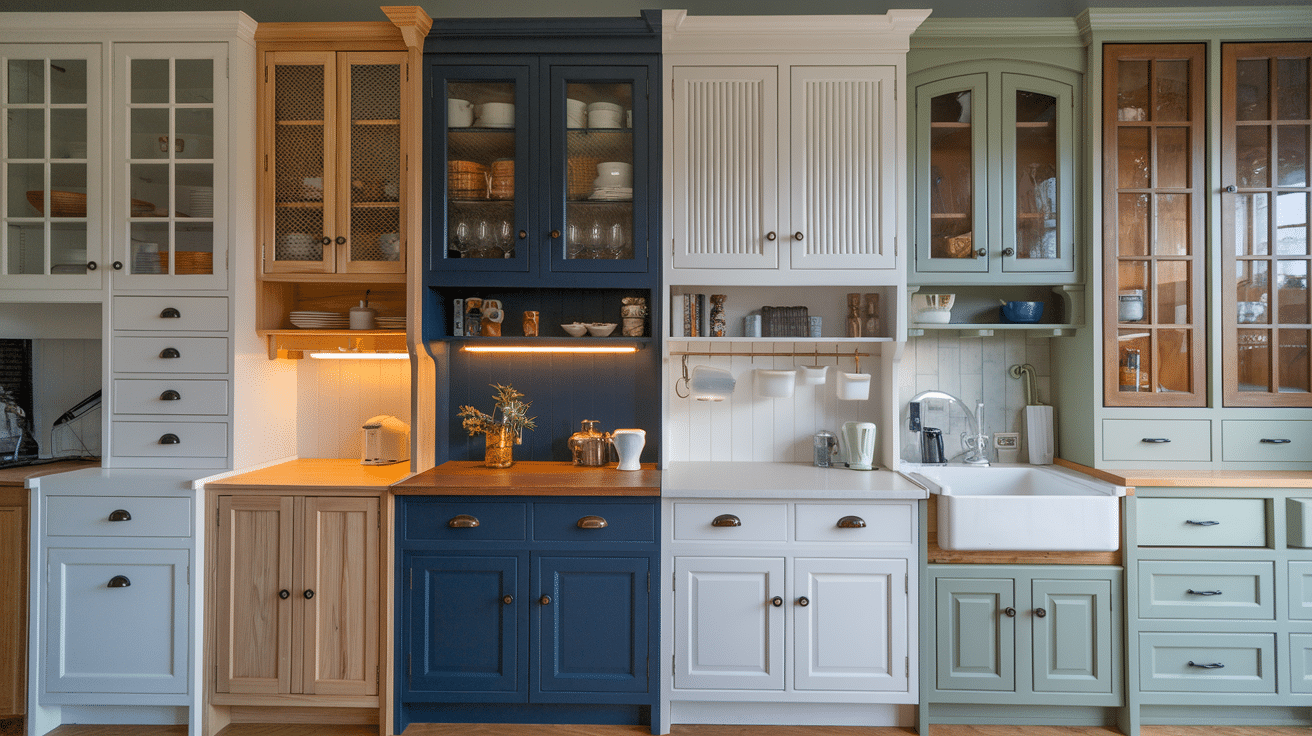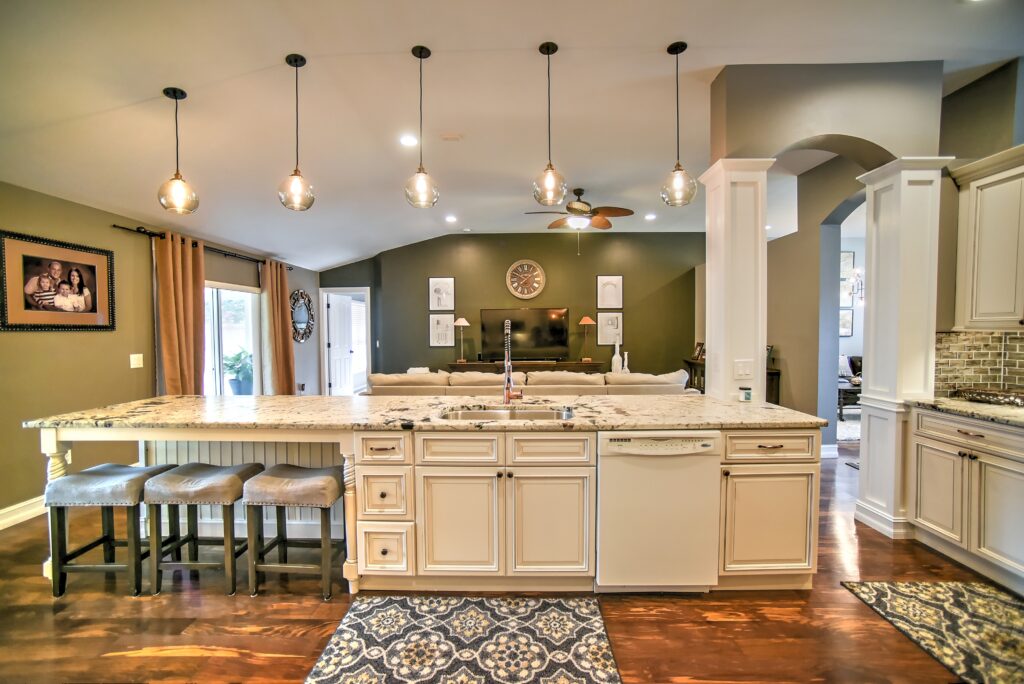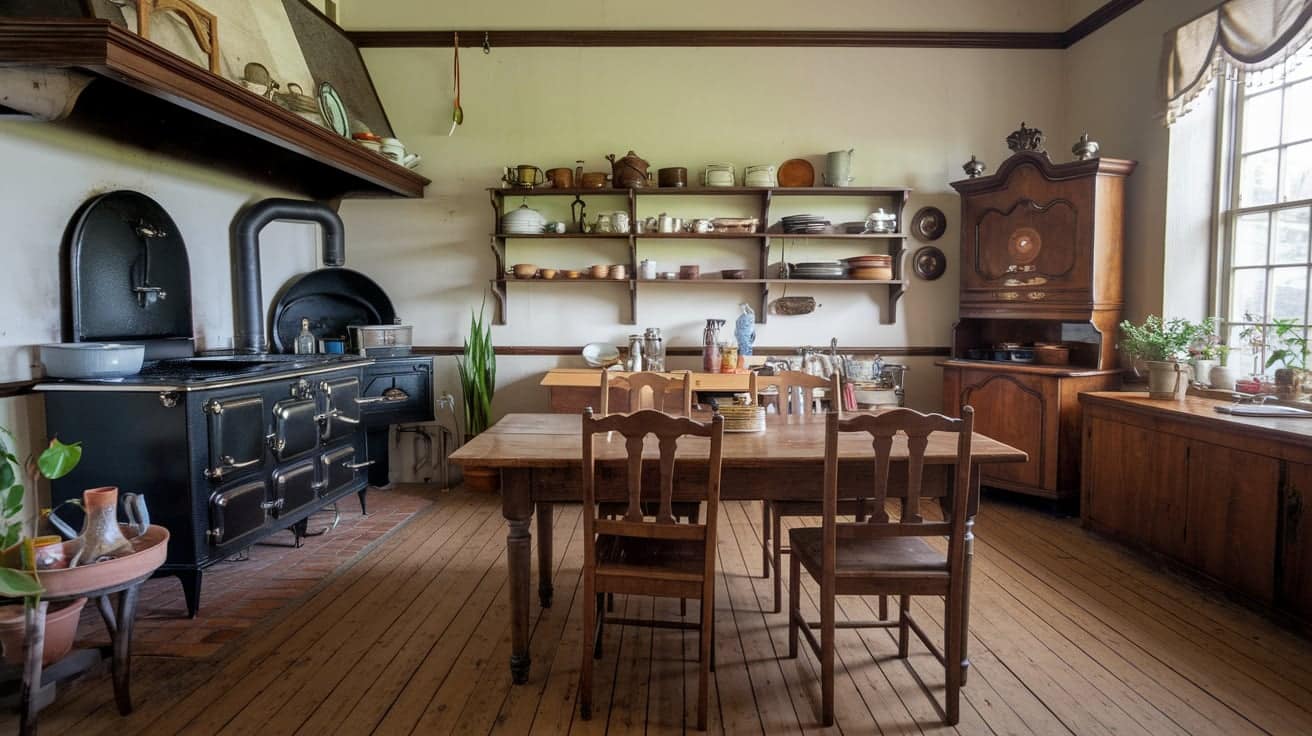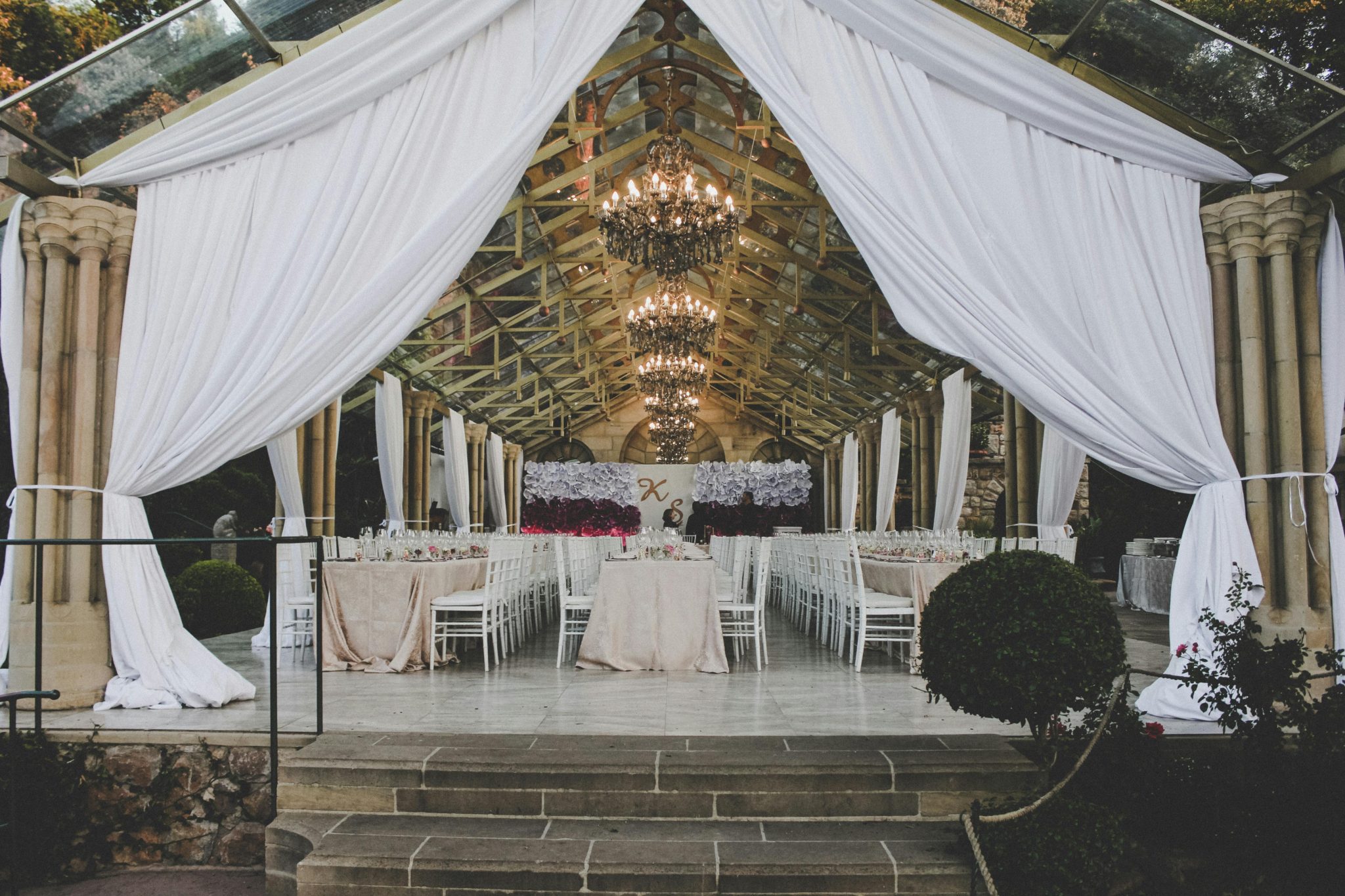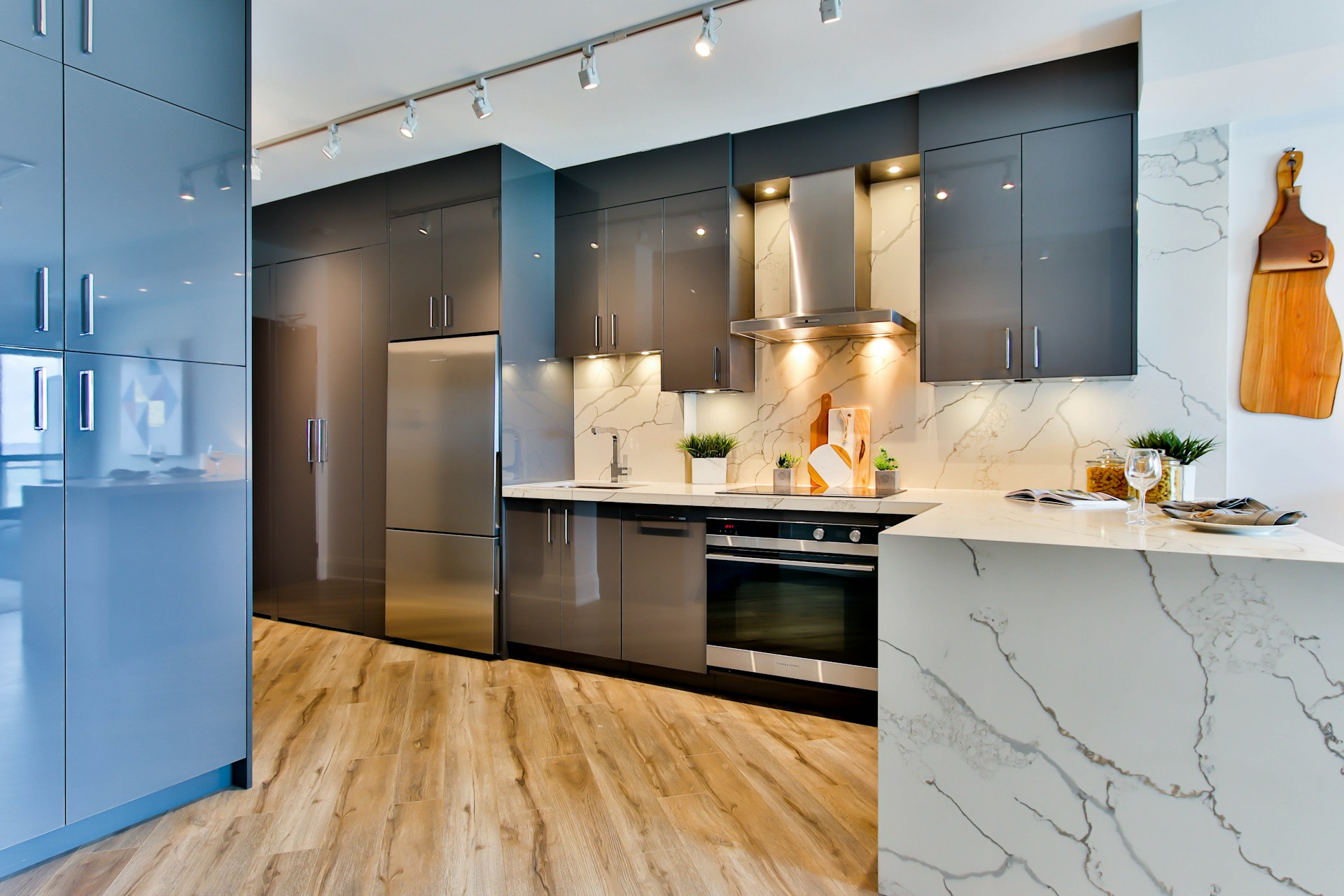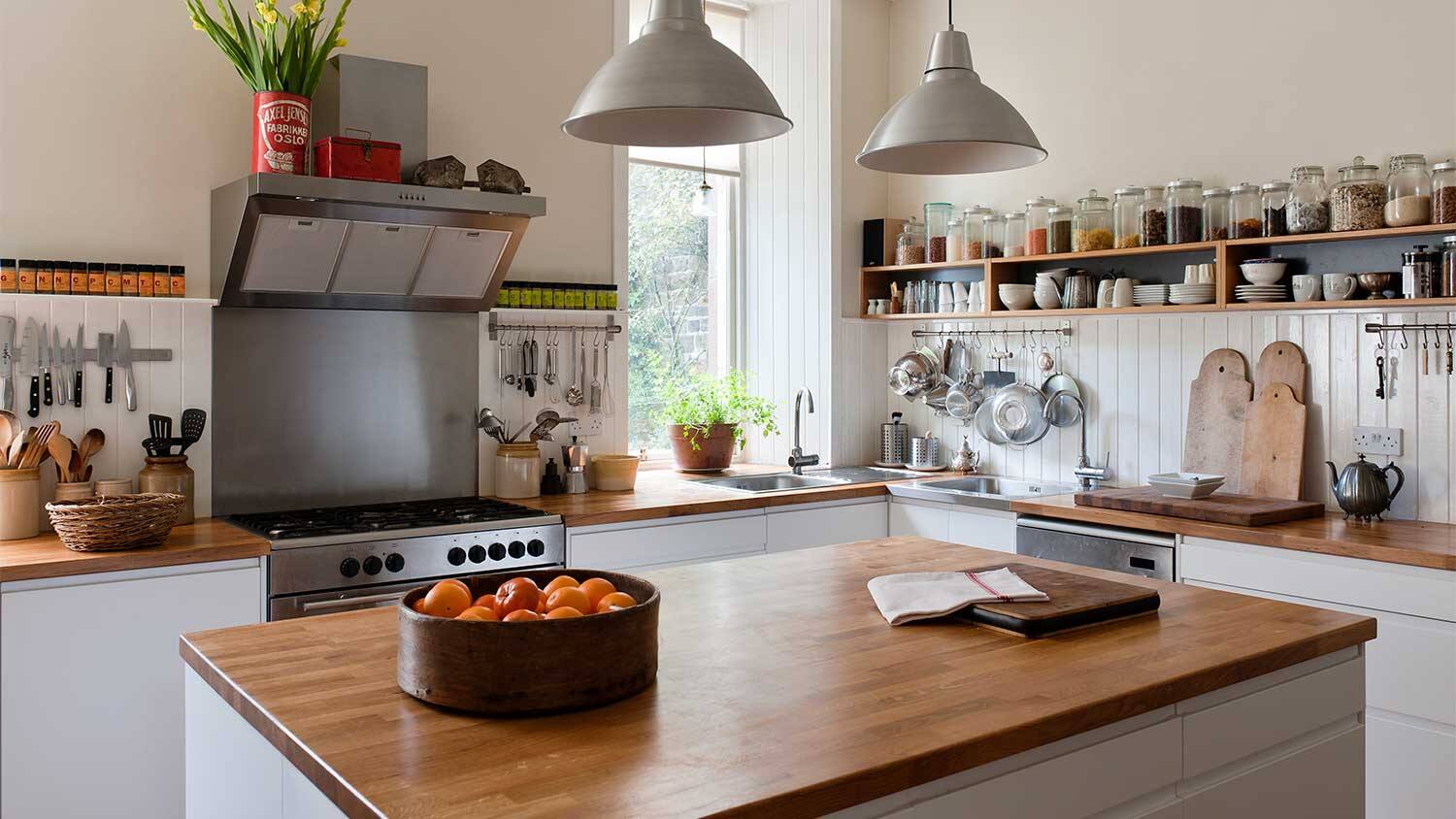Kitchen Cabinet Contruction: Types, Styles, and Colors
When planning a kitchen renovation or building a new home, kitchen cabinets are one of the most important choices you’ll face. They shape how your kitchen looks and how smoothly it works for your daily tasks.
The right cabinets offer more than storage—they bring order, function, and a style that fits your space.
With so many types, materials, and finishes available, it can be hard to know where to begin.
That’s why we’ve put together this helpful guide. You’ll get a clear breakdown of cabinet styles, designs, and layouts so you can pick what works best for your home.
Let’s start with the basics and work our way through all the must-know options.
Types of Kitchen Cabinets
Before choosing a style, it’s helpful to understand the fundamental types of cabinets available and how they’re constructed.
1. Framed vs. Frameless Cabinets
Framed cabinets have a face frame attached to the front of the cabinet box. This frame provides stability and a surface for mounting doors and drawers.
- Pros: Framed cabinets offer a more traditional look with a very stable structure. They’re easier to install and work well with many door styles.
- Cons: These cabinets provide slightly less storage space with more limited access to the interior. They can look bulkier than frameless options.
Also known as European-style cabinets, frameless cabinets don’t have a face frame. The doors attach directly to the cabinet box.
- Pros: Frameless cabinets feature a clean, modern appearance with more interior storage space. They allow wider drawer access and have no center stile in double-door cabinets.
- Cons: They may require more precise installation and are less common in traditional American homes. Without proper construction, they can be less rigid.
2. Cabinet Door Styles
These terms describe how the cabinet doors sit in relation to the frame.
Partial overlay doors: Cover part of the face frame, showing some of the frames around each door and drawer. This is the most affordable option and standard in many homes.
Full overlay doors: Cover almost all of the face frame with minimal frame visible between doors and drawers. This creates a smooth, seamless look at a mid-range price point.
Inset doors: Sit flush with the face frame instead of overlapping it. This creates a clean, precise look but requires very precise construction. It’s the most expensive option, historically found in high-end and custom kitchens.
Comparison Chart
| Type | Appearance | Pros | Cons | |
|---|---|---|---|---|
| Partial Overlay | Some frame visible | Affordable, common | Less modern look | |
| Full Overlay | Minimal frame visible | Clean, contemporary | Requires precise hardware | |
| Inset | Flush with frame | Classic, high-end look | Most expensive, requires precision |
Popular Cabinet Door Styles Explained
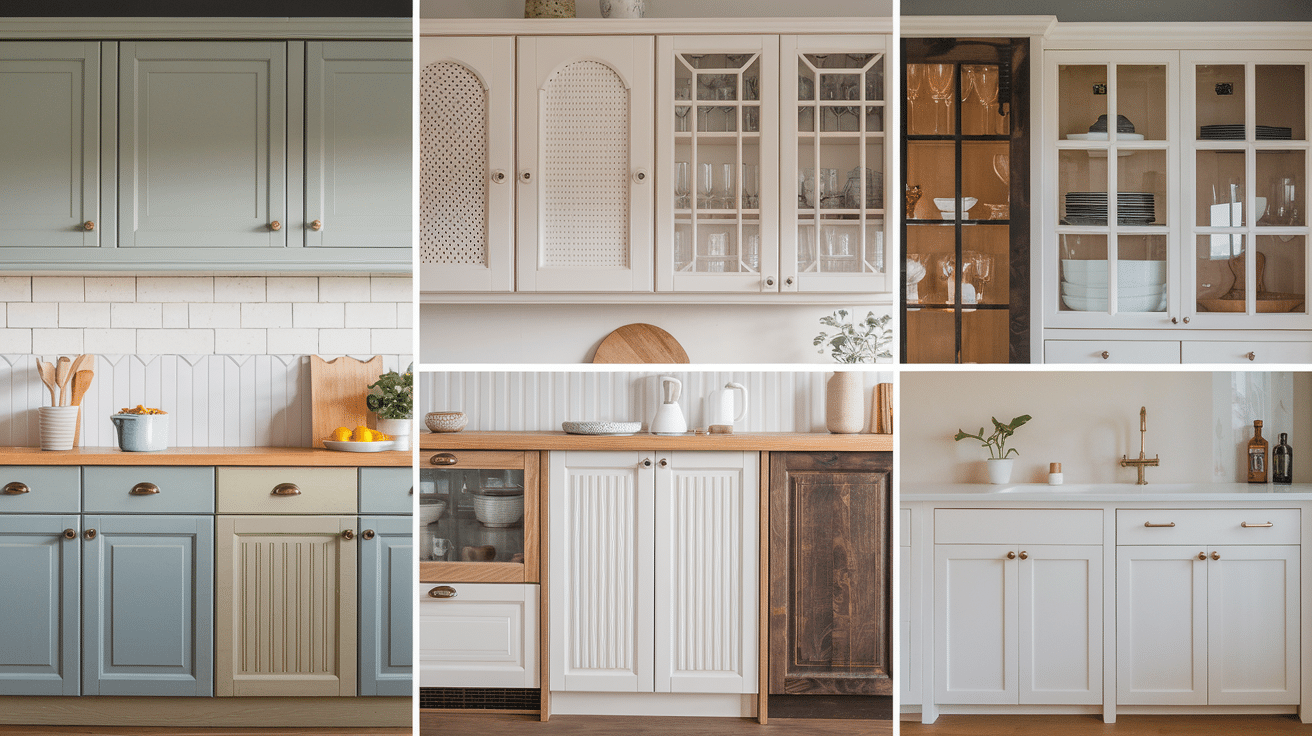
The door style gives your cabinets their main visual character. Here are the most common styles you’ll find:
1. Shaker
Shaker cabinets feature a five-piece door with a recessed center panel and simple, clean lines. This style started with the Shaker religious community in the 1800s and focuses on simplicity and function.
Shaker style works with nearly everything from traditional to modern kitchens, making it the most popular choice today.
2. Slab (Flat-Panel)
Slab doors are smooth, flat panels without frames or contours. This minimalist style creates a clean, contemporary look.
Slab doors are perfect for modern and contemporary kitchens and also work well in mid-century modern designs.
3. Raised Panel
Raised panel doors have a center panel that is raised above the surrounding door frame, often with detailed edge profiles.
This creates depth and shadow lines. They fit well with traditional, classic, and formal kitchen styles.
4. Beadboard
These doors include vertical grooves (beadboard) in the center panel, reminiscent of cottage wainscoting.
Beadboard doors are ideal for cottage, country, and casual kitchen styles. Beadboard gives your kitchen a soft, homey feel. It’s a good pick if you like calm, easygoing spaces that feel lived-in and simple.
5. Louvered
Louvered doors have horizontal slats, like window blinds, with small gaps in between.
They let air flow through, which helps reduce heat and moisture inside cabinets.
These doors are often seen in coastal, tropical, and some traditional-style kitchens. If you like a light and breezy look, this style might be a good fit for your space.
6. Glass-Front Cabinets
These cabinets feature door frames with glass inserts instead of solid panels. The glass can be clear, frosted, seeded, or patterned.
Glass-front cabinets work with many styles to break up solid cabinetry and display special items.
7. Open Shelving
While not technically cabinets, open shelving replaces upper cabinets with exposed shelves.
Open shelving fits contemporary, farmhouse, and minimal kitchen styles.
It gives you quick access to dishes and helps small spaces feel more open. Just keep in mind that items will be on display, so daily use and easy cleanup matter.
Choosing a Style That Matches Your Kitchen

Different cabinet styles work better with certain kitchen design approaches:
1. Traditional
Traditional kitchens typically feature detailed woodwork, warm colors, and classic design elements.
The best cabinet types for traditional kitchens include raised panel doors, framed construction, cherry, maple, or oak wood, decorative moldings and trim, and glazed or antiqued finishes.
2. Transitional
Transitional kitchens blend classic and contemporary elements for a balanced, timeless look.
The best cabinet types for transitional kitchens include Shaker doors, simple panel doors with minimal detail, a mix of painted and wood finishes, clean lines with some decorative elements, and neutral color palettes.
3. Modern and Contemporary
Modern kitchens focus on clean lines, minimal ornamentation, and sleek surfaces.
The best cabinet types for modern kitchens include slab doors, frameless construction, high-gloss or matte finishes, horizontal grain patterns, handle-free designs, and material mixing.
Kitchen Cabinet Color Trends and Finishes
The color of your cabinets sets the tone for your entire kitchen.
How to Build a Cohesive Color Scheme
To create a well-coordinated kitchen, choose cabinet colors that complement your flooring and countertops. Consider your kitchen’s natural light, as darker cabinets need more light.
Test samples in your actual space before committing and remember that cabinet color is a long-term commitment. If using two colors, keep one neutral for balance.
Popular Colors For Kitchen Cabinets
1. White: White cabinets remain extremely popular because they’re light, bright, and timeless. They work well in almost any kitchen style and make spaces feel larger.
2. Wood Tones: Natural wood finishes are making a comeback, with warm medium tones and light oaks gaining popularity. Wood adds warmth and texture to a kitchen.
3. Blue: Blue cabinets have become a new classic, ranging from navy to light blue-gray. They add personality while still feeling somewhat neutral.
4. Green: Green cabinets in sage, mint, and forest tones are increasingly popular, bringing a natural element into kitchens.
5. Two-Toned: Using different colors for upper and lower cabinets or island cabinets creates visual interest. Typical combinations include white uppers with colored lowers or a statement island.
Finish Options
1. Matte: Low-sheen finishes hiding fingerprints and imperfections better than glossy alternatives.
2. Glossy: High-gloss finishes reflect light and create a sleek, modern look but show fingerprints more easily.
3. Distressed: These finishes include intentional wear marks, rub-through, and aging techniques for a vintage or rustic feel.
Cabinet Materials and Durability
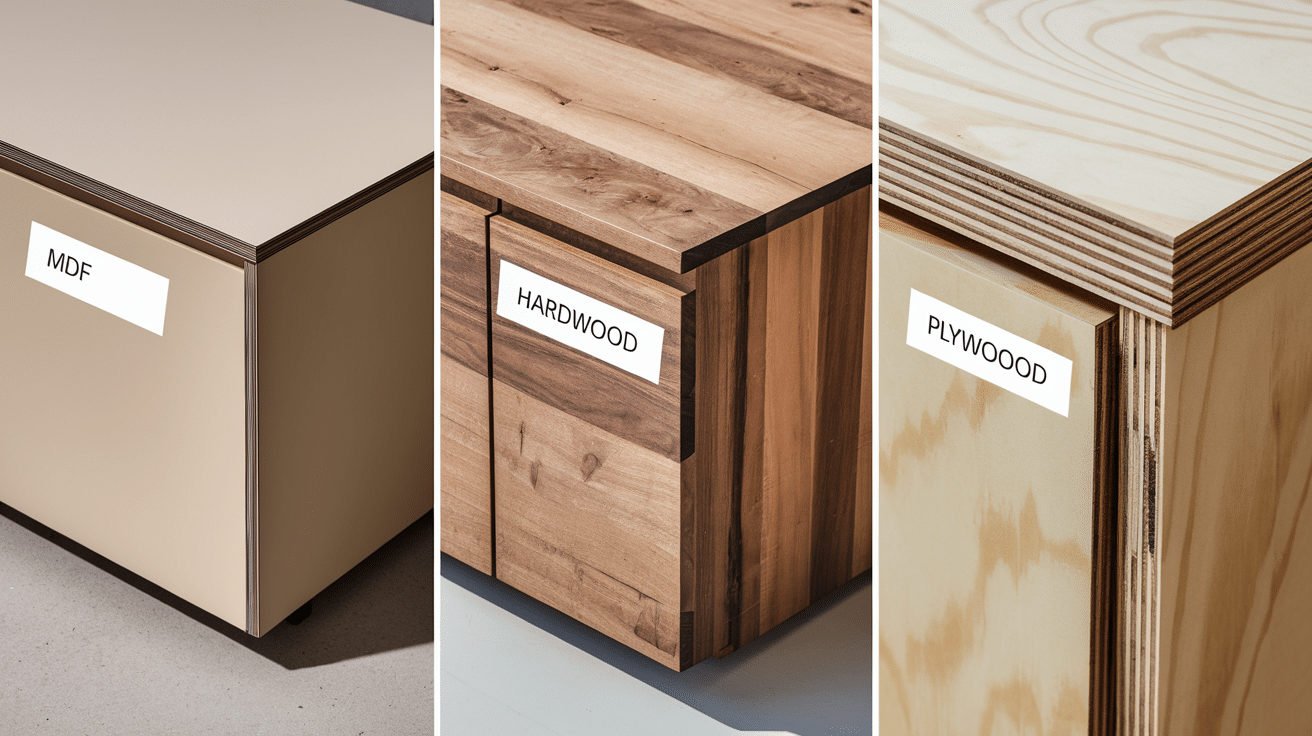
The materials used in your cabinets affect both how they look and how long they last.
Different Cabinet Materials
MDF (Medium-Density Fiberboard): MDF is made from compressed wood fibers and resin. It provides a smooth, consistent surface good for painting and is less expensive than solid wood.
However, it can swell if exposed to moisture. MDF is good for painted cabinet doors.
Hardwood: Hardwood cabinets use solid pieces of lumber with natural beauty and grain patterns. They are very durable and long-lasting but more expensive. Hardwood can expand and contract with humidity changes but is excellent for door frames and visible components.
Plywood: Plywood is made from thin layers of wood bonded together. It’s strong and resistant to warping with better moisture resistance than MDF.
Plywood works well for cabinet boxes and comes at a mid-range cost.
Best Materials for Longevity
Kitchens are often subjected to face humidity, heat, and heavy use. The best materials differ for different parts.
Plywood works best for cabinet boxes, better than particle board. Solid hardwood is the right choice for door frames, but hardwood or quality MDF for painted door panels.
Solid wood or plywood with dovetail joints for drawers, and 3/4″ plywood for shelves to prevent sagging.
Cost and Budget Considerations
Cabinet costs vary widely based on quality, materials, and construction methods.
Cabinet Style vs. Price
Generally, from least to most expensive: Partial overlay, framed cabinets are most affordable, followed by full overlay, framed cabinets, then frameless cabinets, with inset cabinets being the most expensive.
Special features like glass doors, interior organizers, and custom sizes will increase costs.
Custom vs. Stock Cabinets
Stock cabinets are pre-made in standard sizes, making them the most affordable option. They come in limited styles, sizes, and finishes but offer the quickest availability.
Semi-custom cabinets use standard cabinet boxes with some size flexibility. They offer more style and finish options at mid-range pricing, with a typical lead time of 4-8 weeks.
Custom cabinets are made to exact specifications with unlimited style, material, and finish options. They provide the highest quality construction but are the most expensive option, with an 8-12 week typical lead time.
Tips for Budget-Friendly Updates
If new cabinets aren’t in your budget, consider cabinet refacing (replacing only the doors), painting existing cabinets, updating hardware, adding glass inserts to some doors, or removing some doors for open shelving.
Expert Tips for Selecting the Right Cabinets
When choosing cabinets, think about how you use your kitchen each day. Pick a style that fits your space, storage needs, and how much time you want to spend on cleaning.
Flat doors are easier to wipe down, while raised ones may need more care. Try to match cabinet colors with your floors, walls, and counters for a clean and balanced look.
If you plan to mix different cabinet styles, keep it simple by changing only one part, like the island or upper units. Most of all, make sure your choice works for your budget and makes daily use easy.
Questions to Ask Before Choosing
When selecting cabinets, ask yourself these questions. These will help you understand what you really need and help you make the best decision.
- How long do you plan to stay in your home?
- What do you not like about your current cabinets?
- What is your true budget (with a 10-20% buffer)?
- How do you use your kitchen most often?
- What your cleaning and maintenance tolerance is?
Style, Function, and Storage Needs
Consider how you cook and what items you need to store.
Plan for specific storage needs like spices and baking sheets.
Think about accessibility for all household members and balance open storage (visible) versus closed storage (hidden).
Mixing Styles Smartly
You can create interest by thoughtfully combining cabinet styles.
Use glass doors for display cabinets, create a standout island with a different color or style. You could also mix open shelving with traditional cabinets or combine upper and lower cabinet styles that complement each other.
Final Thoughts
Choosing the right kitchen cabinets is a big part of creating a space that fits your daily life. From style and color to layout and function, each detail makes a difference in how your kitchen looks and works.
Think about how much storage you need, how often you cook, and what style fits your home best.
Cabinets should help your kitchen feel organized, comfortable, and easy to use. A smart choice now can make daily tasks smoother and add value later.
Take your time, ask questions, and look at real-life examples. Good kitchen cabinets are more than just shelves and doors—they help bring together the look and use of your kitchen in the best way.

